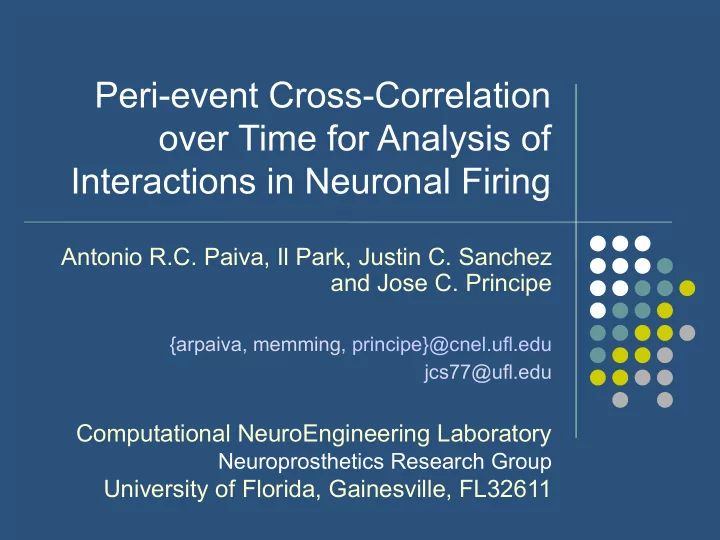

Peri-event Cross-Correlation over Time for Analysis of Interactions in Neuronal Firing Antonio R.C. Paiva, Il Park, Justin C. Sanchez and Jose C. Principe {arpaiva, memming, principe}@cnel.ufl.edu jcs77@ufl.edu Computational NeuroEngineering Laboratory Neuroprosthetics Research Group University of Florida, Gainesville, FL32611
Outline Motivation Generalized cross-correlation Peri-event cross-correlation over time (PECCOT) Results
Analysis problem We want to analyze interactions among neurons over time. Need to assess and measure the temporal dynamics of neural couplings. This is important, for example, for studies on the role of populations in information encoding and/or processing.
Current approaches Cross-correlation, JPSTH, unitary events, partial directed coherence, etc. To deal with non-stationarity, most methods operate over time windows, thereby limiting the temporal resolution of the analysis. Also, most methods are meant to analyze pairs of neurons. Thus, analysis of a large number of neurons with these methods is cumbersome or impractical.
We propose... ... the Peri-Event Cross-Correlation Over Time (PECCOT) because: It measures the coupling of neuron couplings over time with high temporal resolution. Scales easily for a large number of neurons. Is applicable regardless of coupling feature (that is, firing rate or synchrony). Results are easy to visualize.
Cross-Correlation as usual Cross-correlation of two spike trains is typically expressed in term of their binned counterparts, Two main limitations of this perspective: Binning imposes a time quantization Averaging over time further reduces the temporal resolution of the analysis
Generalized Cross-Correlation Binning is an intensity estimator! Hence, using the intensity functions of the underlying point processes we can write a generalized cross-correlation (GCC), Instead of averaging over time, the time resolution can be preserved by approximating the expectation as an average over trials.
PECCOT algorithm 1. For each trial, Estimate intensity function of each neuron around, the event onset Compute the instantaneous cross-correlation for the k - th trial as, between neurons i and j . 4. Average the instantaneous cross-correlation for each pair of neurons across trials.
Results Simulated experiment: dataset Dataset with 3 neurons modulating in response to an event. Introduced stochastic synchrony between neurons A&B, 0.12s before event onset.
Results Simulated experiment: PECCOT
Results Simulated experiment: JPSTH Conceptually, PECCOT expresses the same information as the main diagonal of the JPSTH. By focusing on only this dimension, it shows the interactions over time, but it is much easier to visualize and analyze.
Results Behavioral experiment: dataset Used multielectrode array recordings collected from male Sprague-Dawley rats performing a go-no go lever pressing task. 2×8 electrode array configurations, chronically implanted in the forelimb region of M1. Utilized 39 spike trains (24 left hemisphere, 19 right hemisphere). Averaging was done over 93 left lever presses and 45 right lever presses.
Results Behavioral experiment: PECCOT
Conclusion Presented PECCOT as a simpler and more effective tool to study interactions over time among neurons. Exchanges averaging over time by averaging over realizations to achieve high temporal resolution. Formulation is general and applicable to either the coupling feature is synchrony or rate modulation.
Future work Interesting phenomena was observed in analysis of rat’s motor cortex data. Application of PECCOT to track the evolution of interactions across regions of the brain. PECCOT may be an effective tool to relate meso- and macroscopic recordings (such as LFPs and EEG) to correlated single neuron activity.
Recommend
More recommend